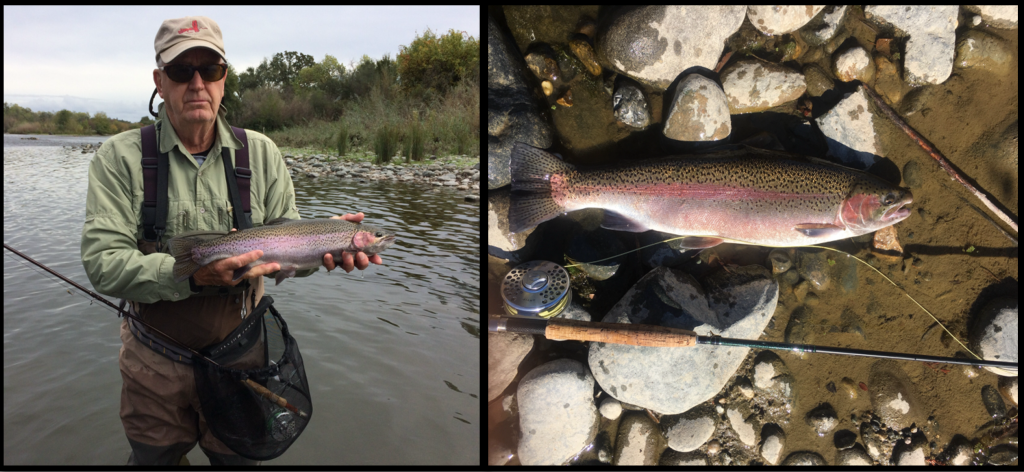
Typical “trophy-sized” rainbow trout caught (and released) in May 2016 from Lake Davis. (Jon Baiocchi photo)
Lake Davis is a popular Sierra trout fishing destination in Plumas County near the town of Portola, California. Lake Davis was created in 1966 when the California Department of Water Resources dammed Grizzly Creek, a tributary of the Middle Fork Feather River, as part of State Water Project. The lake is perhaps best known for its decade-long battle over northern pike extermination efforts by CDFW that ended successfully nearly a decade ago.
Controversy now returns to the lake’s fishery, because catch rates for trout have plummeted again, similar to their decline when pike spread in the lake. This time, the problem seems to be either over-harvest by fishermen or cutbacks in CDFW’s stocking program since the huge hatchery plantings that followed the poisoning of pike (and trout) in the lake a decade ago. Did fishermen become spoiled and harvest too many fish? Or has the state become stingy with its fishery stocking and management programs?
Some speculate the state has become vindictive to ongoing lawsuits brought on by the town government by holding back on stocking. Others note that overall hatchery production, especially of the popular Eagle-Lake strain used in Lake Davis, has suffered during the recent drought. Regardless, the issues beg the question of whether changes are needed in managing some Sierra lake fisheries, if only to protect fragile local Sierra community economies sustained in large part by recreation.
Like many other popular Sierra lakes, Davis is managed by CDFW as a Hatchery Supported Trout Water. It is stocked and managed as a Put-and-Grow and Put-and-Take water. Such waters are capable of supporting trout growth and carry-over survival, but have limited capacity for natural reproduction. For Put-and-Grow fisheries, hatchery-produced trout 3-6 inches in length are stocked periodically to augment the trout population. Put-and-Take waters are stocked with catchable-sized hatchery trout in support of intensive fisheries to support waters near campgrounds, roadsides or other high access areas where angling demand is high, and where anglers often want to keep some fish. California is blessed with many such public waters sustained by CDFW and public utilities’ stocking.
At Lake Davis, many locals, visitors, and guides have noted a gradual decline in catch rates of trout, but an increasing average size of trout over the past four to five years. Catch rates including my own have gone from 20 to 10 per day to 5 to or even 1 or 2 per day. Average size has increased several inches to 20-22 inches, with larger fish common. Rather than faster growth, it appears more fish are reaching their terminal age of 4 to 5 years. A lack of smaller size trout in catches may indicate reduced stocking or poor survival of the 3-12 inch hatchery fish.
Harvest rates of 5 per day are allowed, with 10 in possession. The season is openyear round, and ice fishing is popular. Winter-spring harvest of adult trout near the mouths of spawning creeks is allowed, whereas some other Sierra lakes open in April or May to protect spawning fish. Other quality Sierra lake fisheries have reduced harvest rates of 2 fish per day. Regardless, the lake attracts many diverse fishing interests who have been attracted by high catch rates and the large size of trout over the years.
Other than harvest and stocking rates, what else has changed the lake in recent years? Certainly four years of drought has brought about the gradual drop in lake depth and surface area, with some recovery this winter and spring. Largemouth bass and shiners have returned in small numbers, but thankfully there have been no reports of pike. The trout’s food supply seems recovered and abundant for the most part. The lake’s bed of invasive aquatic Eurasian milfoil plants remains abundant. The lake’s twin sister Davis Lake in southern Oregon with restrictive fly-fishing-only regulations and no trout harvest allowed has also had its trout fishery decline in recent drought years.
Other than stocking more fish or restricting harvest, what else could be done to improve the lake’s fishery? One option I would recommend is raising catchable and trophy sized trout in pens using local funding. This approach was recently begun at Englebright Reservoir on the Yuba River. It is gaining favor throughout the West for enhancing popular high-intensity trout lake fisheries where there is limited natural production and limited conflict with wild-trout populations. On Davis Lake, Honker Cove or the Dam Cove would be good locations for such an endeavor. I would also recommend stocking more sterile triploid trout, as they may grow faster and survive better to older ages by not having the urge to undergo the rigors of spawning.
For further reading on the Lake Davis trout fishery, Sierra lake fishery management, and related issues see the following:






